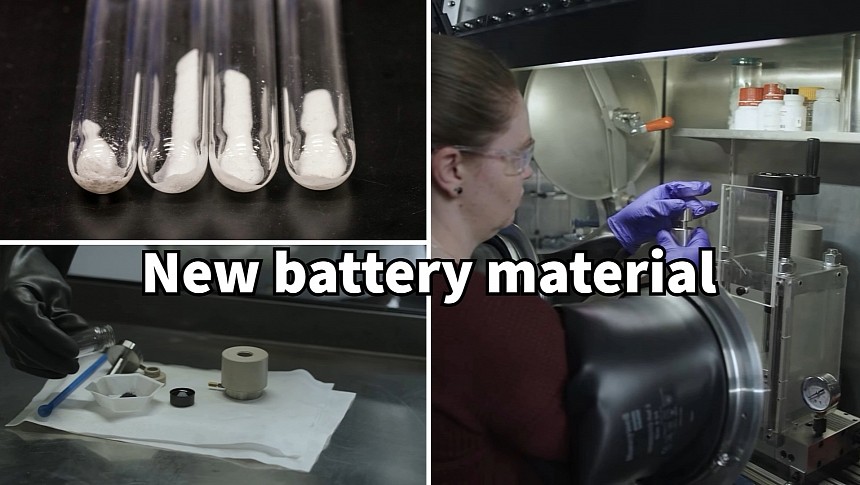Battery technologies don't seem to advance as fast as most people would like them to. However, things are about to drastically change as artificial intelligence enters the field. A partnership between Microsoft and the Pacific Northwest National Laboratory (PNNL) showed how generative AI can be used to discover new battery materials.
Although electric vehicles are far more popular today than they were only two years ago, people still complain about the battery capacity and limited life span. For most, the battery research is not going fast enough, although Li-ion batteries are constantly improving. Other battery chemistries are also developed, although progress is sometimes not visible outside labs.
One reason why things appear to move slower than most expect is the sheer complexity of battery chemistries. There are so many variables to play with that there are literally millions of combinations for a single element in the battery structure, like the electrolyte. Not many of those are viable for commercially produced batteries, so a lot of trial and error must be done before a good battery material is discovered.
Things promise to move much faster by using artificial intelligence to select and filter potential battery materials. Things that usually take humans years of research could be compressed into hours. This allows scientists to skip directly to improving the winning materials and the battery cells instead of wasting precious time to test every possible combination.
If you think this is just theory, Microsoft has already demonstrated it in a partnership with the Pacific Northwest National Laboratory (PNNL). Their AI-driven collaboration resulted in the discovery of a new kind of solid-state electrolyte, which uses a combination of lithium and sodium. The latter is an abundant element, and its use in the new electrolyte would result in a 70% reduction of lithium.
Microsoft offered PNNL its Azure Quantum Elements (AQE) platform that combines high-performance computing and artificial intelligence to speed up discoveries in chemistry and materials science. The PNNL researchers queried AQE for battery materials that use less lithium, and it quickly returned 32 million candidates. The AI system then narrowed down the results to about 500,000 materials that would be stable enough to use in a battery.
Scientists used more filters to select those that conduct energy the best and also simulated how atoms and molecules move within each material. When they accounted for cost and availability, only 23 candidates made the cut, of which five were already known materials. The whole process took only 80 hours, an impressive feat that would've been impossible without artificial intelligence and Microsoft's AQE platform.
In the end, researchers picked one promising candidate from the results and put it to work. A prototype battery has been made from it, and it was used to power a lightbulb and a clock. Don't expect it to reach production any time soon, though, as getting from the lab to the production line could take years of testing and optimizations. However, this study showed that generative AI can tremendously speed up research and offer creative solutions.
One reason why things appear to move slower than most expect is the sheer complexity of battery chemistries. There are so many variables to play with that there are literally millions of combinations for a single element in the battery structure, like the electrolyte. Not many of those are viable for commercially produced batteries, so a lot of trial and error must be done before a good battery material is discovered.
Things promise to move much faster by using artificial intelligence to select and filter potential battery materials. Things that usually take humans years of research could be compressed into hours. This allows scientists to skip directly to improving the winning materials and the battery cells instead of wasting precious time to test every possible combination.
If you think this is just theory, Microsoft has already demonstrated it in a partnership with the Pacific Northwest National Laboratory (PNNL). Their AI-driven collaboration resulted in the discovery of a new kind of solid-state electrolyte, which uses a combination of lithium and sodium. The latter is an abundant element, and its use in the new electrolyte would result in a 70% reduction of lithium.
Microsoft offered PNNL its Azure Quantum Elements (AQE) platform that combines high-performance computing and artificial intelligence to speed up discoveries in chemistry and materials science. The PNNL researchers queried AQE for battery materials that use less lithium, and it quickly returned 32 million candidates. The AI system then narrowed down the results to about 500,000 materials that would be stable enough to use in a battery.
Scientists used more filters to select those that conduct energy the best and also simulated how atoms and molecules move within each material. When they accounted for cost and availability, only 23 candidates made the cut, of which five were already known materials. The whole process took only 80 hours, an impressive feat that would've been impossible without artificial intelligence and Microsoft's AQE platform.
In the end, researchers picked one promising candidate from the results and put it to work. A prototype battery has been made from it, and it was used to power a lightbulb and a clock. Don't expect it to reach production any time soon, though, as getting from the lab to the production line could take years of testing and optimizations. However, this study showed that generative AI can tremendously speed up research and offer creative solutions.









